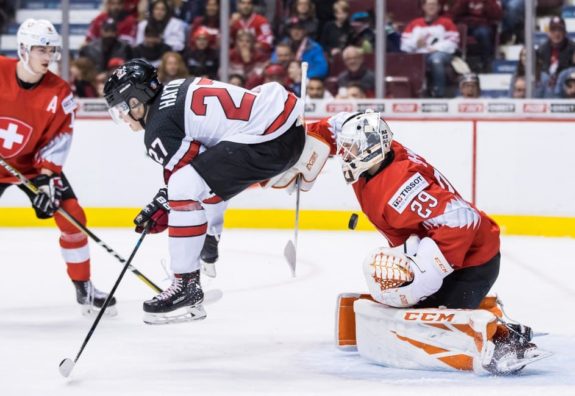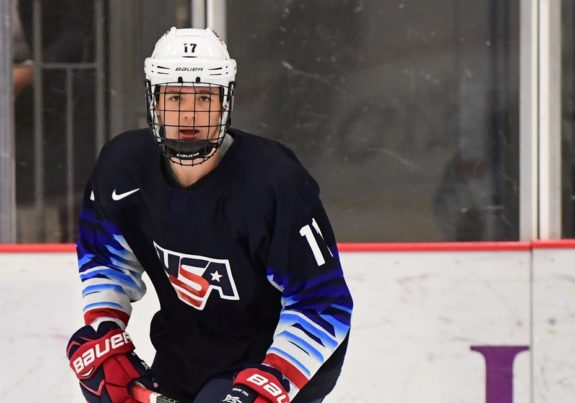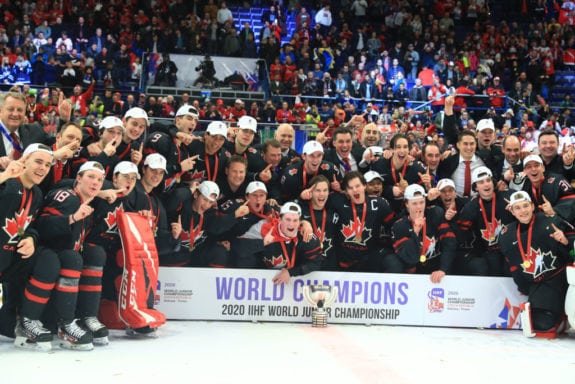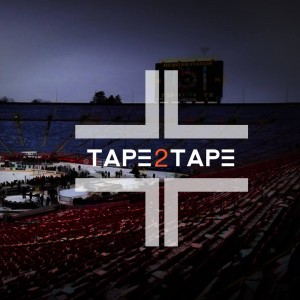
 Andrew Forbes
The Hockey Writers
Andrew Forbes
The Hockey Writers
39
Reads
0
Comments
2020 World Juniors: Controversies & Questions Remain
It’s a tournament that brings the world together over the holiday season – one that unites some of the best junior players from across the world in a best-on-best under-20 tournament so that one country can call themselves the best – at least for the next year.
While there seems to be more and more quality competition on a yearly basis, it was Team Canada that pulled off their 18th gold medal win since the tournament became an official IIHF sanctioned tournament in 1977. While it was yet another classic between Canada and Russia in the gold medal game, the win didn’t come without questions and controversy – something that riddled the tournament from start to finish, right down to the dying minutes of the gold medal game.
Hayton Helmet
For Canada, the headlines started early in the preliminary round. One of the tournament favourites, they opened with back-to-back games against tough opponents in the U.S. squad followed by the Russians.
After disposing of the Americans in a high-scoring 6-4 affair, the Canadians took a thrashing from the Russians in their second game losing 6-0 – a game that chased Nico Daws from the Canadian net for the remainder of the tournament. Aside from it being the worst loss in Canadian World Junior history, there was more headlines surrounding the squad following the game – specifically team captain Barrett Hayton.

Following the loss to Russia, Hayton proceeded to keep his helmet on during the post-game presentations, including the Russian national anthem. Players from the opposing team were outraged and made it known to the referees and Hayton during the post-game handshake.
Hayton, along with Hockey Canada, released statements soon after expressing regret.
“I’m sorry for leaving my helmet on for the Russian anthem following today’s game and Ia apologize to the Russian team and its fans,” said the Canadian captain in the statement. “As a leader on this team, I was trying to process the game and evaluate how we can regroup.”
Hayton went on to congratulate the Russians on their win saying that he needs to be better as the leader of the Canadian squad.
A Heavy Foote
Controversy didn’t stray far from the Canadian team. As they got ready to take on Slovakia in the quarterfinals, no one could’ve expected what was going to happen less than a minute into the game.
The Canadians came out buzzing with both Alexis Lafreniere and Nolan Foote laying huge hits on Slovak defensemen to open the game. While both seemed to be clean, Foote was promptly ejected following his hit on Kristian Kovacik just 53 seconds into the game. He was handed a five-minute major and a game misconduct, not only forcing the Canadians to kill off the major penalty, but leaving them shorthanded for the remainder of the game.
While Foote didn’t face any other supplemental discipline from the IIHF, his lack of presence could’ve been a detriment to Canada’s game. Fortunately for them, the Canadians were able to kill off the penalty and came out on the winning side.

While Foote did lose out on the game, the controversy comes in with the IIHF’s definition of hit to the head. In re-watching the video, Kovacik not only reached for the puck, but tried to avoid the contact. Foote kept his elbow down, his shoulder tucked in and ran the body as he should in any legal check.
With Kovacik reaching for the puck, he lowered his head to elbow level and there was contact made. However, it wasn’t the principle point of contact and Foote did all that he could to make sure that he was laying a proper and legal hit based on IIHF rules. Like a number of rules in any league, those surrounding hits to the head are somewhat of a grey area and, at times, are based on the discretion of the referees. While Foote may have been called for a minor for interference on the play, his ejection was questionable at best.
Speaking of Elbows
In the other quarterfinal matchup, between Finland and the Americans, there were a couple of plays that could’ve led to further discipline. The first, was an elbow from Finland’s Kristian Tanus to the face of U.S. forward Jack Drury.
Coming off the Foote call in the Canada game, it was surprising that Tanus wasn’t even penalized on the play. The team’s leading scorer in the tournament, Tanus stopped right in front of the Finnish bench before lunging and throwing an elbow into the face of Drury.
Related: 2020 NHL Draft – Standouts From the World Juniors
While the Americans were surely up in arms, both during and following the game, Tanus added insult to injury when he assisted on the only goal of the game – scored by Joonas Oden. Tanus played in his team’s semifinal game against Canada and the lack of discipline speaks further to the grey area surrounding the IIHF’s rule against hits to the head.
Even with no penalty on the play, the IIHF has the ability to suspend a player following the game. According to Finland’s GM and TSN’s Bob McKenzie, however, the play wasn’t even reviewed by the federation.
The Plot Thickens in Finland, USA Game
While the Tanus elbow wasn’t reviewed by the IIHF, a hit from behind by USA’s John Beecher on Eemil Erholtz in the same game was reviewed by the federation and Beecher was handed a one-game suspension. The game will have to be served in the 2021 tournament as the Americans were beat by Finland in the quarterfinals.
In a news release, the IIHF explained their decision: “The Disciplinary Panel determined that Beecher’s conduct during the incident was overly aggressive and irresponsible – not only because Beecher drove his body into the back of Erholtz when delivering the check – but also because Beecher, being aware of Erholtz’s vulnerable position, still made the decision to deliver a hard check. Beecher’s actions were dangerous, created a serious risk of injury to Erholtz, and violated IIHF Official Rule 119 (Boarding).”

Beecher was penalized on the play for boarding, but did remain in the game following the play. That said, the suspension does sting a little more with Tanus not having been disciplined at all by the in-game referees or the IIHF following the contest.
While both plays were very different in the actual action, the danger that both hits exhibited should’ve been considered nearly equal – especially with the Tanus elbow being right to the face of Drury. Call it what you will, but the grey area within the IIHF’s rulings does create controversy within the game and within the tournament.
Going After Sandin
Coming off two plays that were quite evident, there was one issue that became more of a story as the tournament went on. Toronto Maple Leafs’ prospect and Swedish defenceman Rasmus Sandin seemed to be facing a number of slashes to the wrist from both the Finnish squad and the Czech team during their quarterfinal win.
Sandin left the game early against the Finns, but after taking a hit in almost the same spot on his wrist, he remained in the game against the Czechs. Sweden went on to beat the host Czechs with a 5-0 win, but the team’s doctor Ryan Allenby said it was clear that their opponents were targeting the young defenceman’s wrist.

“It’s painful, of course,” said Allenby following the game. “It’s in the news. It’s impossible to hide that he was slashed there. Right from the beginning of the game we feel that the Czechs were slashing him on the wrist again. Our players discussed it with the refs, and it kept going on. We expected it and it happened, and we move on.”
The slashes seemed to continue to happen throughout the game and while the Czechs did receive 37 penalty minutes by the end of the game, it wasn’t in relation to the team’s attempts to take out the tournament’s eventual top defenceman.
Who’s the Real MVP?
As for the biggest controversy of the tournament, we circle back to the gold medal winning Canadian squad and their victory over Russia in the gold medal game. Down 3-1, the Canadians stormed back before tallying the go-ahead goal late in the third period.
Down a man with just over a minute left, the Canadians fired a puck over the glass just above the penalty benches where it hit a camera placed their for tournament play. The referees huddled and decided that there would be no penalty on the play. The Russians went on to take two penalties of their own and Canada strolled to victory.

The controversy stems from yet another grey area in the IIHF rules. Under Rule 135 v., a player who lifts the puck from the defending zone and hits the score clock or any structural object above the ice surface, causing a stoppage of play, will not be assessed a penalty.
That said, the camera isn’t a structural object in the arena. In fact, had that camera not been there, the Canadians would’ve fired the puck straight into the crowd and the Russians would’ve had a two-man advantage late in the final frame of the gold medal game.
Still, the team wasn’t assessed a penalty and rolled on to a 4-3 win, capturing the gold medal and the World Junior Championship.
Related: Recapping Team Canada’s Gold Medal Win at WJC
While it’s become a tradition for many to watch the tournament every year, there are still some that were frustrated and confused with some of the calls and plays in this year’s event. The tournament is a solid display of the young talent from around the globe that is up and coming, sure, but at what point does the grey areas in the rulebook take affect in deciding games?
For now, it’s Canada’s gold medal to lose in 2021. But it came with no shortage of headlines, questions and controversies this time around.

Tape2Tape is a column looking at some of the biggest stories from around the world of hockey. Discussing different topics, it focuses on delivering some opinion to hockey’s biggest fans. Whether you agree or disagree, we would love to hear your thoughts.
The post 2020 World Juniors: Controversies & Questions Remain appeared first on The Hockey Writers.
Popular Articles

















































 Blackhawks Chicago
Blackhawks Chicago Panthers Florida
Panthers Florida Penguins Pittsburgh
Penguins Pittsburgh Rangers New York
Rangers New York Avalanche Colorado
Avalanche Colorado Kings Los Angeles
Kings Los Angeles Maple Leafs Toronto
Maple Leafs Toronto Bruins Boston
Bruins Boston Capitals Washington
Capitals Washington Flames Calgary
Flames Calgary Oilers Edmonton
Oilers Edmonton Golden Knights Vegas
Golden Knights Vegas Islanders New York
Islanders New York Sabres Buffalo
Sabres Buffalo Red Wings Detroit
Red Wings Detroit Senators Ottawa
Senators Ottawa Lightning Tampa Bay
Lightning Tampa Bay Flyers Philadelphia
Flyers Philadelphia Devils New Jersey
Devils New Jersey Hurricanes Carolina
Hurricanes Carolina Blue Jackets Columbus
Blue Jackets Columbus Predators Nashville
Predators Nashville Wild Minnesota
Wild Minnesota Blues St. Louis
Blues St. Louis Stars Dallas
Stars Dallas Jets Winnipeg
Jets Winnipeg Mammoth Utah
Mammoth Utah Sharks San Jose
Sharks San Jose Canucks Vancouver
Canucks Vancouver Ducks Anaheim
Ducks Anaheim






